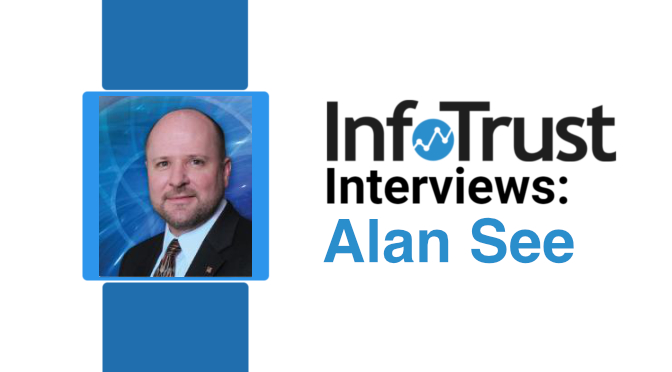
Alan See is Principal and Chief Marketing Officer of CMO Temps, LLC. He has been voted the American Marketing Association “Marketer of the Year” for both Content Marketing and Social Media Marketing. He is also recognized as one of the “Top 50 Most Influential CMO’s on Social Media” by Forbes. Alan is an active blogger and frequent presenter on topics that help organizations develop marketing strategies and sales initiatives to power profitable growth. Alan holds BBA and MBA degrees from Abilene Christian University.
ML: Let’s say you’re on a plane and someone asks who you are. How would you introduce yourself?
AS: I’m Alan See, and I can make your marketing easy.
https://www.youtube.com/watch?v=WJcbgo7Duuw (A catchy tune and shameless shilling 😉 )
ML: If you had to market your services at CMO Temps in one sentence, what would it be?
AS: Fractional CMO leadership. I’m normally not full-time at any one company, but leading marketing organizations for several companies.
ML: What type of organization is perfect for this kind of arrangement? Maybe they’re not yet ready for a full time CMO, maybe they can’t afford a full time CMO but they definitely need somebody to be in charge of marketing?
AS: I work with private equity and venture capital companies, and organizations that are in reorganization or startup mode. I also work with small-to-medium-sized businesses that have not gone full time with a marketing leader or businesses where, perhaps at this point, marketing is actually under their sales leader and they haven’t separated the two disciplines yet.
Within larger organizations, it’s not that I’m leading their marketing organization as much as I’m brought in to be an executive coach. There are senior VP and C-level players who even today have not become fully comfortable with social media, particularly on a personal basis and how that plays into building their personal brand as well as how their personal brand ties in and influences the corporate brand. I’m there as an educational coach and cheerleader for larger brands.
ML: Let’s pretend, as a part time CMO, you begin working with an organization and they tell you that they don’t have any convincing data showing their potential customers are into social. How would you address that concern, question, or misinterpretation of reality?
AS: My phone rings because the company is saying, “We just don’t get it socially, and we now know that we need help, and by the way, our content is crummy.” I’m typically going to be called in because I understand the intersection between content marketing and social media.
ML: When you’re a CMO for an organization, what’s the first thing you do in the morning? What are your top routines when it comes to marketing?
AS: That depends upon which company I’m working for and changes daily. I’m going through the content that’s being created, the content calendar, and how we’re going to create content that addresses every part of the sales funnel, from the very beginning of trying to create interest and credibility. In the B-to-B world with big, high-tech deals, we still do business with people we know, like and trust. Companies are still trying to launch cold calls and get a demo scheduled, and they’re failing miserably. I have to start working on building the credibility and social presence of the sales force.
It’s teaching others how to be social, how to work a room, and how to be able to say something other than, “Hey, can I get a 15-minute demo and bring in our experts so we can beat you over the head with our slideshow?” I look at the content and try to understand the goal. Typically, the goal was to drive traffic to their website.
Is traffic going up? Is the amount of time spent on the website going up or did we do something that drove traffic up but the amount of time spent on the website just dropped like a rock, and everything just bounced? I’m looking for the sweet spot. I want volume going up, I want time on the website going up, and I want it to be going up because we’re driving traffic there with our content through various social channels as well as the traditional channels.
ML: What do you think is the biggest misconception about content marketing?
AS: That you can pull it together overnight. The second thing is that people are truly as interested as you are in your stuff, because they’re not. That is one of the hardest parts of helping people develop content. Instead of being a drone who’s constantly talking about feature functionality of software applications, your content should convey that you actually have a personality, and are somebody who can be liked, respected and trusted.
ML: What do you consider to be the best examples of content marketing? Is there a certain company or campaign that stands out to you?
AS: When it comes to content marketing distributed through social media, I look at it as an evolution. In the beginning what you’re doing is just listening, hardly tweeting and not blogging. You’re just listening trying to get the lay of the land. Then you move to stage two which is becoming a curator. You’re starting to see sites that produce some pretty good stuff. You can see when they’re being self-promotional, but they have good information. As you become a deeper curator you start blogging. You start filling in some of your own material and weaving that in.
I’ve been blogging since the late 90’s and early 2000’s. It’s not that I’m a great writer now. I can tell you, though, that I see a huge difference in my writing when I compare blogs that I’ve written today to blogs, articles and bylines that I wrote years ago. If you stick with it long enough, your writing skills will improve. During that time, if you’ve been savvy about it, you’ve also started building your own audience. We all start with zero followers on Twitter. Now I have nearly 90,000. At this point of my content-marketing life, if that’s what you want to call it, I’ve moved out of curating, and mostly use my own material. It’s my video, blog posts, interviews, and articles. I will retweet major news sources once in a while, and if I’ve been to a big conference, I generally tweet some of my fellow conference speakers’ material.
ML: In one of your blog posts, you talk about the power triangle for sales and business development. Could you elaborate on it a little bit more?
AS: I love that triangle! The power triangle consists of a blog, LinkedIn and Twitter.
The blog can be stand alone, although typically you’re talking about a blog that’s connected to your website. I like to use that blog as a place to be able to quickly present a high-level point of view or opinion. I like to do it in a narrative using a story format. I try to avoid case studies that are nothing more than a regurgitation of facts and data. We’re all natural storytellers, and we like to hear information in a narrative, not in facts and figures.
I’ll also post it on LinkedIn in order to connect with my network there, and finally leverage my Twitter audience by tweeting links to the posts. I can take Twitter, and drive traffic to LinkedIn, to drive traffic to the blog. One builds on the other, and the thing that’s great about Twitter when you start reaching into the tens of thousands of followers is that, in essence, you have the power of a publisher, small newspaper or trade journal. If you’ve been focused on how you’ve managed your Twitter following and who you’re following back, the connections within that particular platform can be very powerful.
ML: In one of your articles, you point out that the most wasted phrase in marketing is : “Feel free to visit our website to learn more about us.” What would you suggest we change this to?
AS: I wouldn’t use it in any form. That kind of weak follow-up is tossed around without any thought. “Okay, I don’t really have anything else to say, so feel free to like us on Facebook, follow us on Twitter, and check out our blog.” Those are all wasted space in my opinion.
I like to connect emotionally through a thought-provoking video or picture, but I’m not ever going to say, “Please go read my blog, please go check out my website.” That’s wasted fluff. It’s something that people see every day, it annoys them, and it’s not going to make them want to go do it.
ML: Is there a phrase in marketing that’s not being used as much as you would like it to be?
AS: “How can I learn more about you?” One thing that helps is to develop a greater sense of empathy. That’s one thing in business that’s frankly kind of tough, because we’re brought up through business school that it’s a dog-eat-dog world and to have empathy would be to show softness. We might fake it, in order to make a customer think we’re engaged and really value their business, but we’re not really going to show empathy, are we?
I believe having an empathetic spirit is one of the best things a marketer can do. Really think about things for a second, through the eyes of the person on the other side of the desk. What are they really going through today, and how can you help?
ML: What’s ahead? Any plans or projects you’re working on that you’d like to share?
AS: In the last five years, there has been a lot of research and conversations between the CMO and the CIO. The number of applications related to marketing which impacts IT infrastructure has skyrocketed so that’s necessitated a lot of conversations between the CIO and the CMO. Currently though, a greater amount of my focus is actually with HR. I say this a bit tongue-in-cheek, but I do feel compelled to consider that HR should be reporting to marketing. I say that from the standpoint that the HR department is alienating way more people than most marketing departments realize.
Consider this: You put an ad in the paper for a Vice President of Sales or Vice President of Marketing. 200 people apply so the first 150 you cycle through quickly and don’t even reply. The next forty you send the template rejection letter. You get down to the five that you actually call and talk to and then the three that are invited in and then you hire one. Out of 200, one person gets the job and that’s the end of the story as far as HR is concerned. However, out of the 199 that were rejected, how many of those have 10’s of thousands of followers on Twitter and other major social platforms?
Organizations need to realize that with dismissals like that, karma is a pain and at some point it will probably sting you. I believe that in the same way that CRM went through a process of ranking the most loyal and profitable customers more care needs to be given to the recruitment process, and how those who aren’t hired are handled. I believe they need to be handled much like you handle a customer that’s disgruntled.. Dismissing them out of hand is dangerous. That’s a long explanation of where my path is going next, but I see a real need developing in this area.
Resources
Connect with Alan on Twitter @AlanSee




